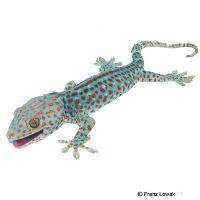Tokay Gecko-Hypomelanistic (Gekko gecko)
| Tokay Gecko-Hypomelanistic Gekko gecko | |
|---|---|
| Name | Tokay Gecko-Hypomelanistic |
| Name Lat. | Gekko gecko |
| Family | Geckos |
| Family lat. | Gekkonidae |
| Order | Scaled Reptiles |
| Order lat. | Squamata |
| Origin | Southeast Asia |
| Habitat | Forests |
| Diet | Insects, fruits |
| Humidity | 60-90 % |
| Behavior | Nocturnal, semi-aggressive |
| Keeping | Pair, harem |
| Care Level | Moderate |
| Reproduction | Oviparous |
| Housing | Humid terrarium |
| Life Span | 15-20 years |
| Protection | CITES Appendix II; EU Annex B |
| Metric Units | |
| Size | 30-35 cm |
| Temperature | 25-28 °C |
| Temperature Local | 30-35 °C |
| Housing Size | 80 x 60 x 100 cm |
| US Units | |
| Size | 12"-14" |
| Temperature | 77-82 °F |
| Temperature Local | 86-95 °F |
| Housing Size | 30" x 25" x 40" |
Distribution and habitat
The arboreal, crepuscular to nocturnal tokeh are widespread in Southeast Asia, from northeastern India to Indonesia and the Philippines, and have also been introduced to Florida, Martinique and Hawaii. They live in the tropical lowland forests on trees and rocks, and also on house walls as crop followers
Maintenance
Minimum dimensions for the terrarium, according to the size and number of animals
| 1-2 animals | 6KRL x 6KRL x 8KRL (L x W x H) |
Head-torso length (KRL) is measured on the largest animal. For each additional animal, increase the footprint by 15%. A terrarium of e.g. 80 x 60 x 100 cm is recommended, which should be placed in a quiet and vibration-free place
You need a terrarium with strong climbing branches, many plants (ficus, ferns, mosses, epiphytes, etc.), rock formations (hiding places and privacy screens), structured back and side walls (e.g. cork lining) and a substrate of forest soil-peat mixture as well as a large water basin (waterfall). Several times a day the inside of the terrarium should be finely sprayed with water (humidity), but a rain or mist system is better.
| Temp. day: 25-28 °C | Temp. night: 20-22 °C | Temp. local: up to 35 °C | Humidity: 60-90 |
Thermostatically controlled floor heating is recommended. Lighting duration must be 12-14 hrs. Daylight fluorescent tubes are ideal. A special UV light is not necessary.
Diet
The diet consists of live insects, such as crickets, house crickets, grasshoppers, cockroaches, zophobas and mealybug larvae, supplemented with some fruit pulp and sweet fruits (e.g. bananas, papaya). Alternatively, special ready-made food for geckos or insectivorous reptiles can be offered. Wax moths should rarely be fed in very small amounts due to their large fat content. Young animals should be offered food daily, adults 4-5 times a week. Regular addition of minerals and vitamins (dusting of feed) is important. Drinking water must always be available, but is preferably taken in drop form from leaves or furnishings. A regular and varied diet promotes health and prevents deficiency symptoms.
Reproduction and breeding
The adult male has a thickened caudal root with a distinct hemipenis pouch.
The female sticks her hard-shelled eggs (2 pieces) to the decoration up to five times a year. At a temperature of 25-30 °C the incubation period is 100-120 days. Both parents perform brood care until the young lose their juvenile coloration.
Species protection
The animal population must be reported in writing to the competent authority immediately after the start of keeping. Subsequently, all arrivals and departures must be reported. Your pet store will be happy to provide you with further information.
Species protection: WA Appendix II; EU Appendix B The proof of purchase is the required proof of origin for the animal. Please keep it safe!
Important
They are bred in numerous color morphs. With their lamellar toes (adhesive toes) they can also climb on smooth, vertical surfaces (e.g. glass).
They are considered to be incompatible and bite. When threatened, they tear their mouths wide open before biting hard and then not letting go for a longer time.
For the resting phase, the lighting duration is shortened by 2-3 hours and the temperature is lowered by 3-4 °C for approx. two months, depending on the origin of the animals
With fruit and honey water as food for the feeders, their quality can be upgraded.
The terrarium must have good ventilation without drafts and meet the species specific needs. Measuring devices such as thermometers, hygrometers, etc. are necessary. The lighting has to correspond to the species-specific day-night rhythm and has to be placed in such a way that the animals cannot injure themselves. The terrarium should be locked in such a way that neither unauthorized persons can open it nor the animals can escape. Contamination must be removed regularly.
Further literature can be found in your pet store.
References
Text: petdata; Image: Franz Lowak
Source: BMELV (1997): Tierschutzgutachten - Mindestanforderungen an die Haltung von Reptilien; ENGELMANN (2006): Zootierhaltung - Tiere in menschlicher Obhut: Reptilien und Amphibien, Harri Deutsch Verlag
- Gemäß § 21 Abs. 5 Tierschutzgesetz idgF
